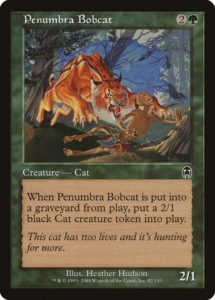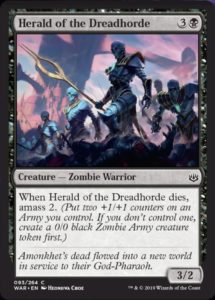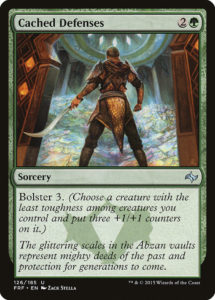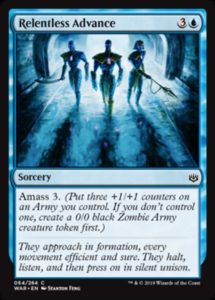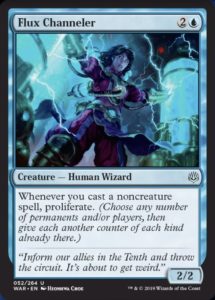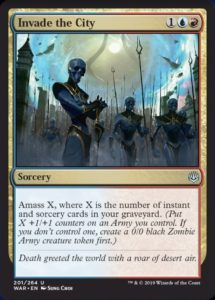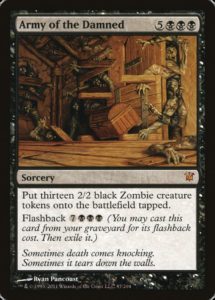War of the Spark spoiler season is finally upon us. At PAX East, we witnessed the first act of Bolas’s plans coming to fruition. We learned that every Planeswalker in the set will have static or triggered abilities, and that the majority will be uncommon. We also witnessed the two set mechanics: Proliferate and Amass.
Today, we’ll focus on Amass, the only brand new mechanic in War of the Spark (though admittedly, the huge leaps in Planeswalker design likely steal the spotlight). Like many new mechanics, Amass has clear mechanical antecedents and card ancestors. However, there’s an interesting tension to Amass that I’m not sure we’ve ever seen before.
Shadows in the Apocalypse
The unnamed penumbra mechanic appeared on only three cards in 2001 (and a single callback card in 2006’s Penumbra Spider). This cycle of green creatures all created a copy of themselves on death, except it was black (because it’s a shadow) and didn’t create a copy of itself (presumably, because shadows don’t have their own shadows, and also the mechanic would be overpowered). Penumbra is a simple mechanic to grok: it’s a 2-for-1. Penumbra creatures reward you playing the attrition game. Accordingly, they cost more than a creature of their stats normally would.
On an army-less board, Herald of the Dreadhorde is a Penumbra Warpath Ghoul (whose shadow is slightly weaker). In fact, we’ve seen almost this exact card in Undead Servant. Every creature that Amasses on death or entering the battlefield has a built-in 2-for-1, making Amass quite the potent ability. However, that’s not all that Amass does.
Outlast the Army
Introduced in 2015’s Fate Reforged, Bolster provides a boost in power and toughness—as long as you have a creature to power up. Moreover, you have limited control over what gets powered up. Bolster is a go-tall mechanic, where you invest multiple resources into a single threat (granted, if you have multiple creatures, it’s not possible to go all-in on Bolstering just one of them). This presents a big problem for your opponent to solve, but it also invites disaster—if your opponent can destroy your Bolstered creature, you’ve let them 2-for-1 you.
Amass lives at the intersection of Bolster and Penumbra. It is a card advantage mechanic when you have no army and a card disadvantage mechanic when you do. There are cards like the aforementioned Herald of the Dreadhorde that provide innate card disadvantage, there are cards like Invade the City (which we’ll get to in a bit) that might do absolutely nothing, and there are cards in the middle. This tension makes Amass trickier to evaluate than it appears.
More or Less than a Hill Giant?
Relentless Advance seems an excellent example of a workhorse, low-power common that might be part of an archetype. On its own, it produces a Hill Giant with zero upside—a thoroughly underpowered creature in Limited. If you already have a zombie army, then it’s a Cached Defenses, which is powerful, but incredibly risky. Sure, the spell has multiple modes, but you have little control over which mode is chosen. This suggests that Amass is worse than the sum of its parts, like Browbeat or Tribute mechanics.
Then again, a Hill Giant made out of +1/+1 counters might have a very real upside. If you proliferate it a single time, you’ve got a four mana 4/4 (a solid creature and exclusively within green’s domain at common). Sure, you won’t be able to get more than an Amass 1 off a Proliferate (since it’s real difficult to have multiple zombie armies), so there’s a low ceiling on the benefit. But turning a 3/3 into a 4/4 is a real boon.
Risky Business
Invade the City is the opposite of Herald of the Dreadhorde. Where Herald was a safe two-for-one, Invade the City involves a huge risk. On an empty board, it might do nothing. If you do have an army and some spells in the graveyard, it’s a build-your own Cached Defenses. That’s not too exciting in Limited. Sure, this could do some really cool things in Constructed alongside Pteramander and Enigma Drake, but both of those cards function well because they can go under your spells. Invade the City looks a whole lot more like Spite of Mogis: cool potential, but no execution.
I really like that Amass runs the full gamut of always-excellent-card-advantage mechanic to inherently-dangerous-card-disadvantage mechanic. Some mechanics, like Investigate and Kicker, are just always good and you evaluate them based on what they’re attached to. Other mechanics, especially Ability Words like Landfall and Spell Mastery, have to be evaluated by what they do on a card-by-card basis. Amass seems like the rare keyword action mechanic that works the same way every time and yet needs to be evaluated on a card-by-card basis. That’s really cool from a design standpoint.
One Dead Man Army
We’ve gone over the execution of Amass, but let’s spend a moment on its narrative. Does Amassing an army feel like having an army of monstrous, Lazotec-covered undead Eternals at your command? Most often, having an army in Magic means going wide with lots of little creatures—your opponent can cut down some of your soldiers, but the survivors will get the job done. We’ve seen this with Army of the Damned. Heck, the Boros Legion, Ravnica’s army-police, play as a go-wide swarm. This army of Eternals is the opposite: a growing, massive swarm that moves as one, commanded by a singular entity (like Bolas, or Liliana, or you). If it’s destroyed, you’ll just Amass another one.
There’s dissonance here. Now, this could be a good thing—much of Amonkhet’s narrative strength was reinforced by how the mechanics harnessed the twisted, cruel world Bolas had bent to his will. This would be particularly apt, since these Eternals are all from Amonkhet. However, going against the way that armies are done in Magic could break immersion. Only time and playtesting will tell.
I’m excited to see not only all the ways that Amass is executed in War of the Spark, but also how it’s supported. For example, I really don’t expect there to be a common Pacifism, since it completely shuts down Amass. I’d expect a more generically powerful (but less damaging to Amss) common like Isolation Zone. Only time will tell, and fortunately we don’t have to wait long to see more cards.
And, as always, thanks for reading.
—Zachary Barash is a New York City-based game designer and the commissioner of Team Draft League. He designs for Kingdom Death: Monster, has a Game Design MFA from the NYU Game Center, and does freelance game design. When the stars align, he streams Magic.
His favorite card of the month is Conviction. While initially designed as an aura that wasn’t nigh-guaranteed card advantage, it’s proven far more flexible over a decade later in sets like Aether Revolt (where it enabled Revolt) and Ultimate Masters (where it was quite strong alongside Heroic).

